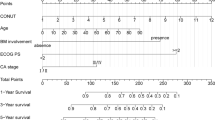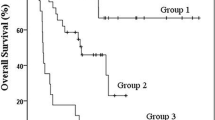Abstract
The prognostic nutritional index (PNI), an indicator of nutritional status and systemic inflammation, is associated with survival in several types of tumors. The prognostic value of the PNI in lymphoma remains unclear. The present study aimed to evaluate the prognostic significance of the PNI in patients with extranodal natural killer/T cell lymphoma, nasal type (ENKTL). This retrospective study in two institutions was comprised of 177 patients with newly diagnosed ENKTL. Patients with a combined albumin (g/L) + 5 × total lymphocyte count × 109/l ≥ 45 were allocated a PNI score of 0. Patients in whom this total was <45 were allocated a score of 1. Patients with a pretreatment PNI score of 1 had more adverse clinical features, lower complete remission rates (p = 0.005), and worse overall survival (OS, p < 0.001) and progression-free survival (p = 0.004) compared with those with a PNI score of 0. Multivariate analysis showed that the PNI (p < 0.001) and tumor mass ≥5 cm (p < 0.001) were independent predictors of worse OS. The PNI was predictive in extranasal disease and nasal disease (both p < 0.05). The PNI could differentiate low-risk patients as classified according to the International Prognostic Index and Prognosis Index for peripheral T cell lymphoma scoring, as well as patients in a different category using the Korean Prognostic Index scores with different survival outcomes (all p < 0.05). The PNI is a powerful predictor of survival in ENKTL. Nutritional status and inflammatory responses at diagnosis might play an important role in survival in patients with ENKTL.




Similar content being viewed by others
References
Guo H-Q, Huang G-L, Guo C-C, Pu X-X, Lin T-Y (2010) Diagnostic and prognostic value of circulating miR-221 for extranodal natural killer/T-cell lymphoma. Dis Markers 29(5):251–258
Al-Hakeem DA, Fedele S, Carlos R, Porter S (2007) Extranodal NK/T-cell lymphoma, nasal type. Oral Oncol 43(1):4–14
Chim CS, Ma SY, Au WY, Choy C, Lie AK, Liang R, Yau CC, Kwong YL (2004) Primary nasal natural killer cell lymphoma: long-term treatment outcome and relationship with the International Prognostic Index. Blood 103(1):216–221. doi:10.1182/blood-2003-05-1401
Cheung MM, Chan JK, Lau WH, Ngan RK, Foo WW (2002) Early stage nasal NK/T-cell lymphoma: clinical outcome, prognostic factors, and the effect of treatment modality. Int J Radiat Oncol Biol Phys 54(1):182–190
Au WY, Weisenburger DD, Intragumtornchai T, Nakamura S, Kim WS, Sng I, Vose J, Armitage JO, Liang R (2009) Clinical differences between nasal and extranasal natural killer/T-cell lymphoma: a study of 136 cases from the International Peripheral T-Cell Lymphoma Project. Blood 113(17):3931–3937. doi:10.1182/blood-2008-10-185256
Rodriguez J, Conde E, Gutierrez A, Arranz R, Leon A, Marin J, Bendandi M, Albo C, Caballero MD (2007) The results of consolidation with autologous stem-cell transplantation in patients with peripheral T-cell lymphoma (PTCL) in first complete remission: the Spanish Lymphoma and Autologous Transplantation Group experience. Ann Oncol 18(4):652–657. doi:10.1093/annonc/mdl466
Park BB, Ryoo BY, Lee JH, Kwon HC, Yang SH, Kang HJ, Kim HJ, Oh SY, Ko YH, Huh JR, Lee SS, Nam EM, Park KW, Kim JH, Kang JH, Bang SM, Park S, Kim K, Park K, Suh C, Kim WS (2007) Clinical features and treatment outcomes of angioimmunoblastic T-cell lymphoma. Leuk Lymphoma 48(4):716–722. doi:10.1080/10428190601123989
Huang JJ, Jiang WQ, Lin TY, Huang Y, Xu RH, Huang HQ, Li ZM (2011) Absolute lymphocyte count is a novel prognostic indicator in extranodal natural killer/T-cell lymphoma, nasal type. Ann Oncol 22(1):149–155. doi:10.1093/annonc/mdq314
Dalia S, Chavez J, Little B, Bello C, Fisher K, Lee JH, Chervenick P, Sokol L, Sotomayor E, Shah B (2014) Serum albumin retains independent prognostic significance in diffuse large B-cell lymphoma in the post-rituximab era. Ann Hematol 93(8):1305–1312. doi:10.1007/s00277-014-2031-2
Arcaini L, Lazzarino M, Colombo N, Burcheri S, Boveri E, Paulli M, Morra E, Gambacorta M, Cortelazzo S, Tucci A, Ungari M, Ambrosetti A, Menestrina F, Orsucci L, Novero D, Pulsoni A, Frezzato M, Gaidano G, Vallisa D, Minardi V, Tripodo C, Callea V, Baldini L, Merli F, Federico M, Franco V, Iannitto E (2006) Splenic marginal zone lymphoma: a prognostic model for clinical use. Blood 107(12):4643–4649. doi:10.1182/blood-2005-11-4659
Hasenclever D, Diehl V (1998) A prognostic score for advanced Hodgkin’s disease. International Prognostic Factors Project on Advanced Hodgkin’s Disease. N Engl J Med 339(21):1506–1514. doi:10.1056/nejm199811193392104
Sun K, Chen S, Xu J, Li G, He Y (2014) The prognostic significance of the prognostic nutritional index in cancer: a systematic review and meta-analysis. J Cancer Res Clin Oncol. doi:10.1007/s00432-014-1714-3
Pinato DJ, North BV, Sharma R (2012) A novel, externally validated inflammation-based prognostic algorithm in hepatocellular carcinoma: the prognostic nutritional index (PNI). Br J Cancer 106(8):1439–1445. doi:10.1038/bjc.2012.92
Kinoshita A, Onoda H, Imai N, Iwaku A, Oishi M, Fushiya N, Koike K, Nishino H, Tajiri H (2012) Comparison of the prognostic value of inflammation-based prognostic scores in patients with hepatocellular carcinoma. Br J Cancer 107(6):988–993. doi:10.1038/bjc.2012.354
Lee J, Suh C, Park YH, Ko YH, Bang SM, Lee JH, Lee DH, Huh J, Oh SY, Kwon HC, Kim HJ, Lee SI, Kim JH, Park J, Oh SJ, Kim K, Jung C, Park K, Kim WS (2006) Extranodal natural killer T-cell lymphoma, nasal-type: a prognostic model from a retrospective multicenter study. J Clin Oncol 24(4):612–618. doi:10.1200/jco.2005.04.1384
Cai Q, Luo X, Liang Y, Rao H, Fang X, Jiang W, Lin T, Lin T, Huang H (2013) Fasting blood glucose is a novel prognostic indicator for extranodal natural killer/T-cell lymphoma, nasal type. Br J Cancer 108(2):380–386. doi:10.1038/bjc.2012.566
Lee J, Park YH, Kim WS, Lee SS, Ryoo BY, Yang SH, Park KW, Kang JH, Park JO, Lee SH, Kim K, Jung CW, Park YS, Im YH, Kang WK, Lee MH, Ko YH, Ahn YC, Park K (2005) Extranodal nasal type NK/T-cell lymphoma: elucidating clinical prognostic factors for risk-based stratification of therapy. Eur J Cancer 41(10):1402–1408. doi:10.1016/j.ejca.2005.03.010
Kim TM, Heo DS (2009) Extranodal NK/T-cell lymphoma, nasal type: new staging system and treatment strategies. Cancer Sci 100(12):2242–2248
Proctor MJ, Morrison DS, Talwar D, Balmer SM, Fletcher CD, O'Reilly DS, Foulis AK, Horgan PG, McMillan DC (2011) A comparison of inflammation-based prognostic scores in patients with cancer. A Glasgow Inflammation Outcome Study. Eur J Cancer 47(17):2633–2641. doi:10.1016/j.ejca.2011.03.028
Cheson BD, Horning SJ, Coiffier B, Shipp MA, Fisher RI, Connors JM, Lister TA, Vose J, Grillo-Lopez A, Hagenbeek A, Cabanillas F, Klippensten D, Hiddemann W, Castellino R, Harris NL, Armitage JO, Carter W, Hoppe R, Canellos GP (1999) Report of an international workshop to standardize response criteria for non-Hodgkin’s lymphomas. NCI Sponsored International Working Group. J Clin Oncol 17(4):1244
Grillo-Lopez AJ, Cheson BD, Horning SJ, Peterson BA, Carter WD, Varns CL, Klippenstein DL, Shen CD (2000) Response criteria for NHL: importance of ‘normal’ lymph node size and correlations with response rates. Ann Oncol 11(4):399–408
Buzby GP, Mullen JL, Matthews DC, Hobbs CL, Rosato EF (1980) Prognostic Nutritional Index in gastrointestinal surgery. Am J Surg 139(1):160–167
Aviles A, Yanez J, Lopez T, Garcia EL, Guzman R, Diaz-Maqueo JC (1995) Malnutrition as an adverse prognostic factor in patients with diffuse large cell lymphoma. Arch Med Res 26(1):31–34
McMillan DC (2009) Systemic inflammation, nutritional status and survival in patients with cancer. Curr Opin Clin Nutr Metab Care 12(3):223–226. doi:10.1097/MCO.0b013e32832a7902
Ray-Coquard I, Cropet C, Van Glabbeke M, Sebban C, Le Cesne A, Judson I, Tredan O, Verweij J, Biron P, Labidi I, Guastalla JP, Bachelot T, Perol D, Chabaud S, Hogendoorn PC, Cassier P, Dufresne A, Blay JY (2009) Lymphopenia as a prognostic factor for overall survival in advanced carcinomas, sarcomas, and lymphomas. Cancer Res 69(13):5383–5391. doi:10.1158/0008-5472.can-08-3845
Gupta D, Lis CG (2010) Pretreatment serum albumin as a predictor of cancer survival: a systematic review of the epidemiological literature. Nutr J 9:69. doi:10.1186/1475-2891-9-69
McMillan DC, Watson WS, O'Gorman P, Preston T, Scott HR, McArdle CS (2001) Albumin concentrations are primarily determined by the body cell mass and the systemic inflammatory response in cancer patients with weight loss. Nutr Cancer 39(2):210–213. doi:10.1207/S15327914nc392_8
Balkwill F, Mantovani A (2001) Inflammation and cancer: back to Virchow? Lancet 357(9255):539–545. doi:10.1016/s0140-6736(00)04046-0
Jee SH, Shen SC, Chiu HC, Tsai WL, Kuo ML (2001) Overexpression of interleukin-6 in human basal cell carcinoma cell lines increases anti-apoptotic activity and tumorigenic potency. Oncogene 20(2):198–208. doi:10.1038/sj.onc.1204076
Charles KA, Rivory LP, Brown SL, Liddle C, Clarke SJ, Robertson GR (2006) Transcriptional repression of hepatic cytochrome P450 3A4 gene in the presence of cancer. Clin Cancer Res 12(24):7492–7497. doi:10.1158/1078-0432.ccr-06-0023
Rivory LP, Slaviero KA, Clarke SJ (2002) Hepatic cytochrome P450 3A drug metabolism is reduced in cancer patients who have an acute-phase response. Br J Cancer 87(3):277–280. doi:10.1038/sj.bjc.6600448
Murry DJ, Riva L, Poplack DG (1998) Impact of nutrition on pharmacokinetics of anti-neoplastic agents. Int J Cancer Suppl 11:48–51
Kitayama J, Yasuda K, Kawai K, Sunami E, Nagawa H (2011) Circulating lymphocyte is an important determinant of the effectiveness of preoperative radiotherapy in advanced rectal cancer. BMC Cancer 11:64. doi:10.1186/1471-2407-11-64
Li G, Gao J, Liu ZG, Tao YL, Xu BQ, Tu ZW, Zhang XP, Zeng MS, Xia YF (2014) Influence of pretreatment ideal body weight percentile and albumin on prognosis of nasopharyngeal carcinoma: long-term outcomes of 512 patients from a single institution. Head Neck 36(5):660–666. doi:10.1002/hed.23357
Gergely L, Vancsa A, Miltenyi Z, Simon Z, Barath S, Illes A (2011) Pretreatment T lymphocyte numbers are contributing to the prognostic significance of absolute lymphocyte numbers in B-cell non-Hodgkins lymphomas. Pathol Oncol Res 17(2):249–255. doi:10.1007/s12253-010-9306-2
Wahlin BE, Sundstrom C, Holte H, Hagberg H, Erlanson M, Nilsson-Ehle H, Linden O, Nordstrom M, Ostenstad B, Geisler CH, Brown Pde N, Lehtinen T, Maisenholder M, Tierens AM, Sander B, Christensson B, Kimby E (2011) T cells in tumors and blood predict outcome in follicular lymphoma treated with rituximab. Clin Cancer Res 17(12):4136–4144. doi:10.1158/1078-0432.ccr-11-0264
Morales D, Beltran B, De Mendoza FH, Riva L, Yabar A, Quiñones P, Butera JN, Castillo J (2010) Epstein-Barr virus as a prognostic factor in de novo nodal diffuse large B-cell lymphoma. Leuk Lymphoma 51(1):66–72, 1042-8194
Li YJ, Jiang WQ, Huang JJ, Xia ZJ, Huang HQ, Li ZM (2013) The Glasgow Prognostic Score (GPS) as a novel and significant predictor of extranodal natural killer/T-cell lymphoma, nasal type. Am J Hematol 88(5):394–399. doi:10.1002/ajh.23422
Guo CC, Huang Y, Xiao J, Zhang YJ, Tian Y, Wang SS, Cao YB, Fu X, Zhai LZ, Lin TY (2008) Prognostic impact of circulating Epstein-Barr virus (EBV) DNA concentration and EBV serology in T-cell non-Hodgkin's lymphoma (T-NHL). In: ASCO, 26, 15S, p 8556
Ito Y, Kimura H, Maeda Y, Hashimoto C, Ishida F, Izutsu K, Fukushima N, Isobe Y, Takizawa J, Hasegawa Y, Kobayashi H, Okamura S, Kobayashi H, Yamaguchi M, Suzumiya J, Hyo R, Nakamura S, Kawa K, Oshimi K, Suzuki R (2012) Pretreatment EBV-DNA copy number is predictive of response and toxicities to SMILE chemotherapy for extranodal NK/T-cell lymphoma, nasal type. Clin Cancer Res 18(15):4183–4190. doi:10.1158/1078-0432.ccr-12-1064
Vazquez A, Khan MN, Blake DM, Sanghvi S, Baredes S, Eloy JA (2014) Extranodal natural killer/T-Cell lymphoma: a population-based comparison of sinonasal and extranasal disease. Laryngoscope 124(4):888–895. doi:10.1002/lary.24371
Acknowledgments
This work was supported by the National Natural Science Foundation of China (no. 81372883, 81001052, and 81172244), the Science and Technology Planning Project of Guangdong Province, China (no. 2011B031800222), Young Talents Project of Sun Yat-Sen University Cancer Center (to Cai Qingqing), Young Talents Project of Sun Yat-Sen University (to Cai Qingqing), the Natural Science Foundation of Guangdong Province, China (no. 8151008901000043), and the Foundation of Novartis Pharma (to Cai Qingqing).
Conflict of interest
The authors declare no conflicts of interest.
Author information
Authors and Affiliations
Corresponding author
Additional information
Kai-Lin Chen, Yan-Hui Liu and Wen-Yu Li contributed equally to this work.
Rights and permissions
About this article
Cite this article
Chen, KL., Liu, YH., Li, WY. et al. The prognostic nutritional index predicts survival for patients with extranodal natural killer/T cell lymphoma, nasal type. Ann Hematol 94, 1389–1400 (2015). https://doi.org/10.1007/s00277-015-2361-8
Received:
Accepted:
Published:
Issue Date:
DOI: https://doi.org/10.1007/s00277-015-2361-8




